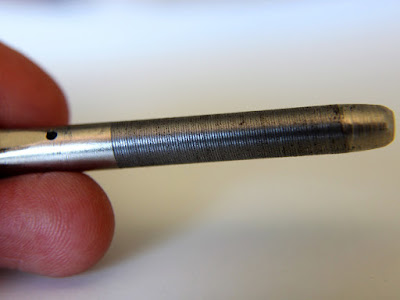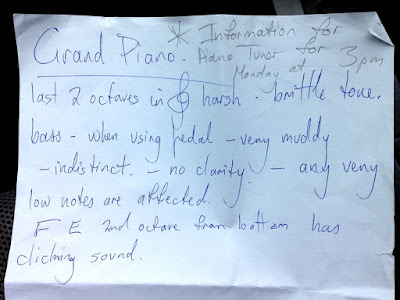
Piano tuning pins have a 'dummy' thread, a scored section that goes into the cross-laminated hardwood pin block. They do screw 'in' and 'out' but not in the manner that a screw enters a threaded hole.
Tuning pins are driven in during installation. The 'dummy' thread is scored onto the pins in such a way that they grip more one way than the other, sharks' teeth-style.

Tuning pins come in boxes (or smaller lots, bagged). These pins are not new, they have been removed from that piano. There are 220 pins in a box, weighing 4.2kg.
Piano tuners receive lots of notes. It is helpful. To us every note on the piano might sound like shit and be out of mechanical regulation, so it is useful to know which ones are bothering the client (if you can't meet face-to-face at the piano). "Will tune next year" is another oft-trotted-out trope in the tuner's world. It is false economy to delay tuning until it bothers the cloth ear.
A bloody long list from a precocious and ambitious young lass. Something that 'rings' is generally a damper problem. 'Bottom' this and 'top' that is not always clear (but it usually is). The term "Super bottom B" amused. At least it's unambiguous. Have the Mario Brothers developed a music system? That barely makes sense. Just don't google 'super bottom'.
Desirable ways to identify notes are:
1. Scientific pitch notation.The octave starting on Middle C is Octave 4.
2. Keystick numbering. It's very piano factory and will not be a client's natural choice. But I like to honour its existence because it's quaint and functional. So listen up, readers. The lowest note is 1 and the highest (on most pianos) is 88. One had better not miscount. Note names are obviously worth including. Thus it's better to consider the usual piano range as being from A1 to C88. Middle C is C40.
Other notation systems may lead to confusion. Who could forget the client who misused Helmholtz pitch notation and had her obedient piano doctors obsessing over a note that didn't bother the client in the slightest? Not us. I don't recommend Helmholtz even for the few folk who know the ins and outs of apostrophes. Too risky.
Nothing beats labelling the notes themselves. It's all 'good'...
...erm, perhaps. I convinced the client to move this struggling piano to a more piano-friendly micro-climate within the house.
A music teacher wishes for a much more esteemed piano. Improvements were made with a combination of voicing the hammers, and twisting* the bass strings, which is not for the faint-hearted.
It's enough to give me an existensial (sic) crisis. It appears that one staff member at this eatery may have corrected the signwriting of another.
It's a fine time to pick up a takeaway container full of apostrophes. Otherwise this cafe owner's family will be eating their words for dinner.
On the home front I received this note from the next door neighbours.
It was a reasonable and charitable gesture.
The shrill piercing whines wore me down. I have sensitive ears. It was a little better when this puppy reached puberty and her voice broke. Queen of PPE** that's me.
I spied this sign in Lithgow. Should I have made one just like it to put up next door?
I have sensitive ears. When tuning I wear these. It is (perhaps to some) surprising to learn that naked pianos can be loud, and one cannot play in a wussy way to tune. If you do this all day every day (like so many sound-laden pursuits) you may suffer some form of hearing loss eventually.
I've secured the door with earmuffs so it will stay open while we get the piano tilter up the stairs and into the good room. But I thought the walls had ears, Cazzbo.
That's right, Queen of PPE, that's me. This photo turned up on Farcebook. I had no idea it existed. I was ahead of my time insisting on wearing a duck floaty while sitting in the bucket of an earth-moving machine. My sister sits to my left, unprotected. Is it because she is only second in line to the Throne? The neighbour kids at least have sun protection.
A good dog is one that is silent and pays me no attention. Barking from behind a front door sees me reaching for my earplugs before I've even met the client or entered the house. It seems weird to be wearing earplugs before I've rung the doorbell, but I have done it. At least I've not worn a duck floaty (in recent times).
My billet house at Woodford Folk Festival had a "loving family dog" which was always muzzled in my presence. I reasoned that their description must have meant that the dog hated all non-family members. I never entered the back verandah and took this photo through the rear window. If they felt a muzzle was necessary, then so did I. It was not in my 'rider' as a performer to see all pooches muzzled, but perhaps it should be.
Apostrophe-spotting aside, this note amused. It was in a theatre where I tuned.
OK, which one of you munchkins has been smoking the Master's cigars?
Behold, twitchers, a naked woodpecker. I've discussed 'exploded hammers' where the felt covering bursts off the wooden core. It usually happens in bass hammers which are bigger and fatter, meaning the felt wrap is held on under more tension, just waiting to spring off if the piano is neglected, aged or subject to too many weather variations. You know a piano in strife when it's happening in the upper treble. The hammer I have pushed forward has lost its felt entirely.
Is this aged care facility run by the Mario Brothers? Mmmm, it all sounds delicious. Fortunately I know just enough to realise that here we're talking 'first floor' and so on. I need not hunt on every level for my intended prey, indeed, a piano.
Marge learns that 'vendetta' means 'vendetta'.
The keypad instructions to exit the same facility. It made me wonder. Could a resident have a moment of uncharacteristic lucidity and solve the puzzle? Retro-grade retrograde.
Old Newtown town.
The internet has far too few cats. I learn that this client's cat's cut is called the 'lion cut'.
Look at that tail.
A note-naming no-no. Retrograde studies aside, this treatment of any piano is beyond irksome. It's also a terrible way to learn your notes (or should I say an excellent way NOT to learn your notes). That's not how you finger contrary-motion scales. I don't care if you're a budding Xenakis with a penchant for musical Sudoku, this is not on. Not. On. Xenakis would never have discriminated against the blacks.
Notice that the right (sustain) pedal is turned inward a bit. Pigeon-toed. There was a lot of lateral movement there.
Fortunately I was able to tighten the screws that held the assembly to the floor of the piano.

Remember, there's always Plan B, a toasty wippen fire.
* When copper-wound bass strings are installed they are twisted in the direction which will 'tighten' the winding (or wrap). How many twists (half a turn, one, or one-and-a-half) will depend on the gauge of the string. Lacklustre bass strings can sometimes be livened up and given more chance to project with an extra half- or full-twist. In a frail piano with old strings the required de-tensioning and then bringing back up to pitch risks string breakage. Still, twisting is (at times) a worthy option.
** Personal protective equipment.
Pianos: Getting Hitched
The Caped Regulators: Pianos, high and low.
Pianos: Under the weather
The Piano Team: Strings, scrubs pants and fireplace fodder.
Goanna Roundup
Pianos: The Colour Purple
Pianos: Things that go 'clunk' in the night
Pianos: House and Garden Varieties
Pianos: Coffee, art and coffee art.
Pianos: The Clunker Chronicles
Domestic(ated) pianos, a homely homily
Smog the mog (cats, pianos)
LIST OF BLOG POSTS




























